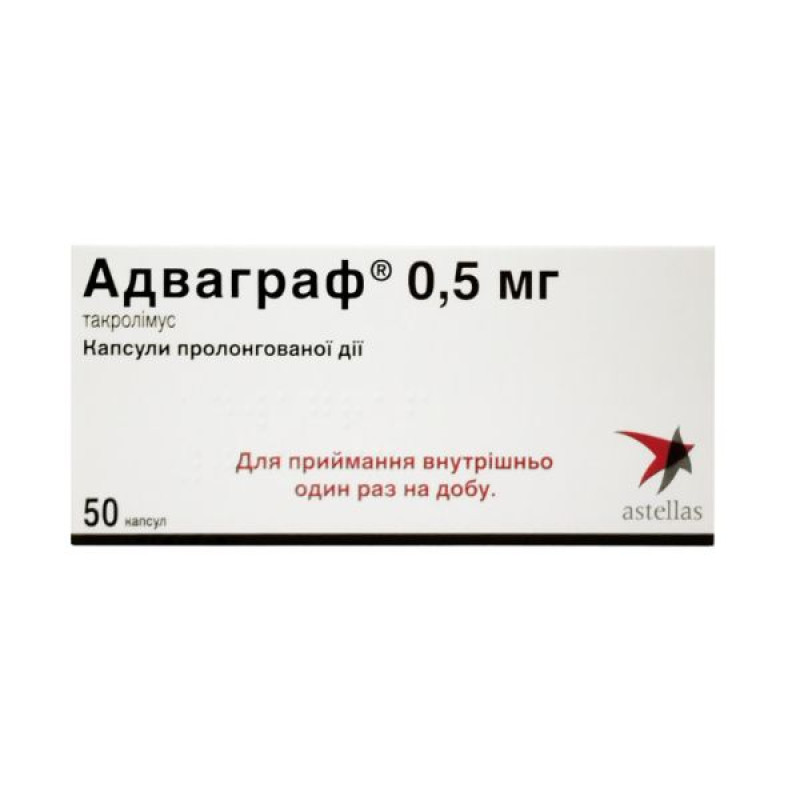Advagraf prolonged-release capsules 0.5 mg No. 50

Advagraf is an immunosuppressant. Calcineurin inhibitor. Indications for use - prevention and treatment of liver and kidney allograft rejection in adult patients; treatment of allograft rejection resistant to standard immunosuppressive therapy regimens in adult patients.
Warehouse
1 capsule contains tacrolimus (as crystalline hydrate) 0.5 mg; excipients: hypromellose, ethylcellulose, lactose monohydrate, magnesium stearate; capsule shell: titanium dioxide (E 171), iron oxide yellow (E 172), iron oxide red (E 172), gelatin, sodium lauryl sulfate; printing ink (Opacode S-1-15013): shellac, lecithin (soy), simethicone, iron oxide red (E 172), hyprolose.Contraindication
Hypersensitivity to tacrolimus, other macrolides or to any of the excipients.
Method of application
Advagraf is an oral form of tacrolimus that is taken once a day.
Prevention of kidney transplant rejection
Oral Advagraf therapy should be initiated at a daily dose of 0.2–0.3 mg/kg/day, administered as a single dose in the morning. The drug should be initiated within 24 hours after transplantation.
The dose of Advagraf should usually be reduced in the post-transplant period. In some cases, concomitant immunosuppressive therapy may be withdrawn, leading to Advagraf monotherapy. Post-transplant changes in the patient's condition may alter the pharmacokinetics of tacrolimus and require further adjustment of the Advagraf dose.
Prevention of liver transplant rejection
Oral Advagraf therapy should be initiated at a daily dose of 0.1–0.2 mg/kg once daily in the morning. Administration should be initiated 12–18 hours after transplantation.
Application features
Medication errors have been reported, including accidental, unintentional or uncontrolled substitution of immediate-release or prolonged-release tacrolimus formulations. This may lead to serious adverse reactions, including graft rejection, or other adverse reactions that may be due to either insufficient or excessive exposure to tacrolimus. Patients should receive a single formulation of tacrolimus with the appropriate daily dosing regimen; changes in formulation or regimen should only be made under the close supervision of a transplant specialist.
There are no clinical data on the use of Advagraf prolonged-release in adult patients with rejection refractory to therapy with other immunosuppressants.
Pregnant women
Tacrolimus treatment of pregnant women should only be permitted in cases where there is no safer alternative and when the potential benefit to the pregnant woman justifies the potential risk to the fetus.
Children
The safety and efficacy of Advagraf in children have not yet been established. Limited data are available but no dosage recommendations can be made based on these data.
Drivers
Tacrolimus can cause visual and neurological disorders, especially when combined with Advagraf and alcohol.
There are no studies on the effect of tacrolimus (Advagraf) on the ability to drive or operate other machinery.
Overdose
Information on overdose is limited. Several cases of accidental overdose have been reported in patients taking tacrolimus. Symptoms included tremor, headache, nausea, vomiting, infections, urticaria, lethargy, and elevations in blood urea nitrogen, serum creatinine, and alanine aminotransferase.
Side effects
From the blood and lymphatic system: anemia, thrombocytopenia, leukopenia, abnormalities in erythrocyte parameters, leukocytosis, coagulopathy, pancytopenia, neutropenia, changes in coagulation parameters and bleeding, thrombocytic thrombocytopenic purpura, hypoprothrombinemia, thrombotic microangiopathy.
Immune system disorders: Allergic and anaphylactoid reactions have been reported in patients receiving tacrolimus.
From the endocrine system: hirsutism.
Storage conditions
Store in the original packaging at a temperature not exceeding 25 °C.
Keep out of reach of children.
There are no reviews for this product.
There are no reviews for this product, be the first to leave your review.
No questions about this product, be the first and ask your question.





